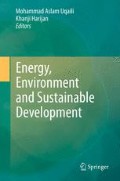Abstract
Electricity has brought many things that surely have made many wonders and life would seem so hard without it. Electricity powers our light, heating, electronic appliances such as computers and television, pumping water, and a host of essential services that we take for granted. The demand of electricity in Pakistan is increasing rapidly despite its disrupted supply. Its demand in the Agricultural and Services sectors of the country is dependent on GDP and the past year’s electricity demand. Various models have been developed to forecast the demand. Autotendential models have been used for first approximation; then different energy economic models have been used. Finally, statistically significant MDEE model has been used. Durbin–Watson d- and h-statistic, adjusted R 2 values, and F-statistic have been found statistically significant. The Modified Dynamic Energy Economic model used in this study takes Ordinary Least Squares (OLS) technique into account. This chapter forecasts the electricity demand for the Agricultural and Services sectors, under different scenarios for the period 2007–2030. It results in that the demand will be in the range of 82,000–122,000 GWh in the year 2030.
Access this chapter
Tax calculation will be finalised at checkout
Purchases are for personal use only
References
GOP (2007) Economic survey of Pakistan 2007-08. Economic Advisor’s Wing, Finance Division, Government of Pakistan, Islamabad, June 2008
Daily Dawn Karachi, Pakistan, January 6, 2007
USAID (2008) 2008 World population data sheet. Population Reference Bureau, USAID, Washington, DC, USA
HDIP (2010) Pakistan energy year book 2009. Hydrocarbon Development Institute of Pakistan, Islamabad, Pakistan
WAPDA (1998) “Load Forecast Update”, Issue 28. Water and Power Development Authority, Government of Pakistan, Lahore, Pakistan
WAPDA (2007) Power system statistics. Water and Power Development Authority, Government of Pakistan, Lahore, Pakistan
Uqaili MA, Valasai GD, Memon HR Meeting power generation choices for Pakistan in presence of diminishing fuel resources and environmental constraints. In: Paper presented at international conference on environmental horizons, University of Karachi, Karachi, 19–21 Dec 2005
Daily The Nation, Islamabad, Pakistan, Thursday, Sept 18, 2008.
Memon HR, Uqaili MA, Valasai GD, Panhwar MI Analysis of the power generation energy sources in Pakistan. In: Paper presented and published in the proceedings of the international conference on environment (ICENV 2006), Grand Plaza Parkroyal, Batu Ferringhi, Penang, Malaysia, 13–15 Nov 2006
Azhar, Tanveer (1991) The quest for power: Pakistan policy options for the nineties. Ferozsons, Lahore
Qureshi AS, Akhtar M, Sarwar A (2003) Effects of electricity pricing policies on groundwater management in Pakistan. Pakistan J Water Resour 7(2):1–9
Siddiqui R (1999) Demand for energy and the revenue impact of changes in energy prices. Research Report No. 174, Pakistan Institute of Development Economics, Islamabad, Pakistan
Uqaili MA (1996) Energy modelling and energy policy in Pakistan. Ph.D. Thesis, Leeds University, UK
Uqaili MA, Harijan K, Memon MD (2007) Prospects of renewable energy for meeting growing electricity demand in Pakistan. Renewable energy for sustainable development in the Asia Pacific region. AIP Conf Proc 941:53–61
NTDC (2003) Load forecast based on regression analysis (Forecast Period 2003–04 to 2024–25). Planning Department, National Transmission and Dispatch, October 2003
Acknowledgments
The authors acknowledge the Departments of Electrical Engineering and Mechanical Engineering and the Institute of Petroleum and Natural Gas Engineering, Mehran University of Engineering and Technology, Jamshoro, Pakistan, for providing the library and laboratory to carry out this research work. The author also greatly acknowledge the Higher Education Commission, Government of Pakistan, for providing financial support.
Author information
Authors and Affiliations
Corresponding author
Editor information
Editors and Affiliations
Rights and permissions
Copyright information
© 2012 Springer-Verlag/Wien
About this chapter
Cite this chapter
Valasai, G., Uqaili, M.A., Memon, H.u.R., Harijan, K. (2012). Forecasting Electricity Demand for Agricultural and Services Sector of Pakistan. In: Uqaili, M., Harijan, K. (eds) Energy, Environment and Sustainable Development. Springer, Vienna. https://doi.org/10.1007/978-3-7091-0109-4_9
Download citation
DOI: https://doi.org/10.1007/978-3-7091-0109-4_9
Published:
Publisher Name: Springer, Vienna
Print ISBN: 978-3-7091-0108-7
Online ISBN: 978-3-7091-0109-4
eBook Packages: Earth and Environmental ScienceEarth and Environmental Science (R0)

